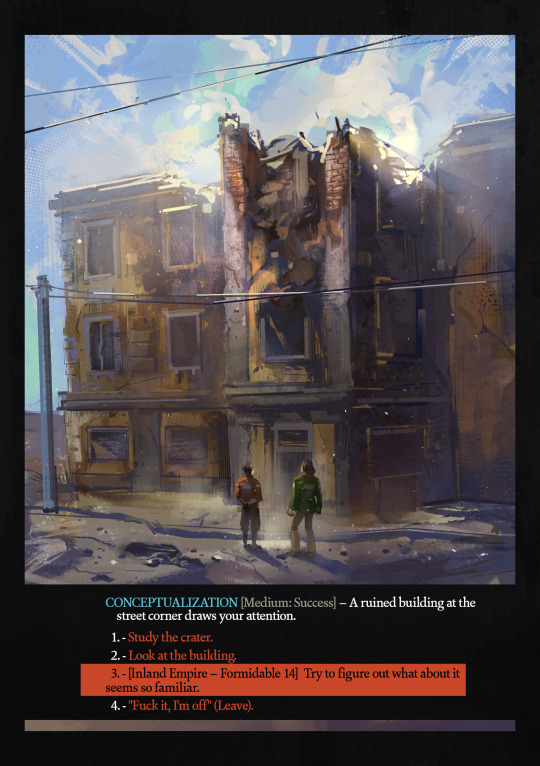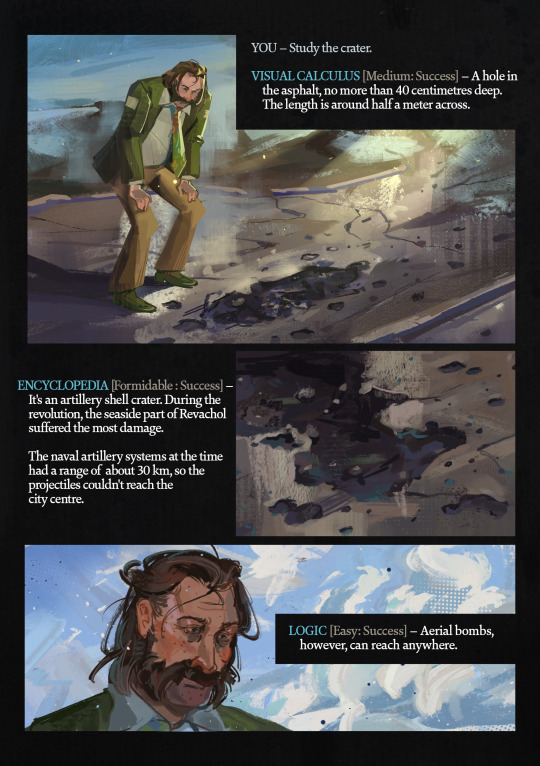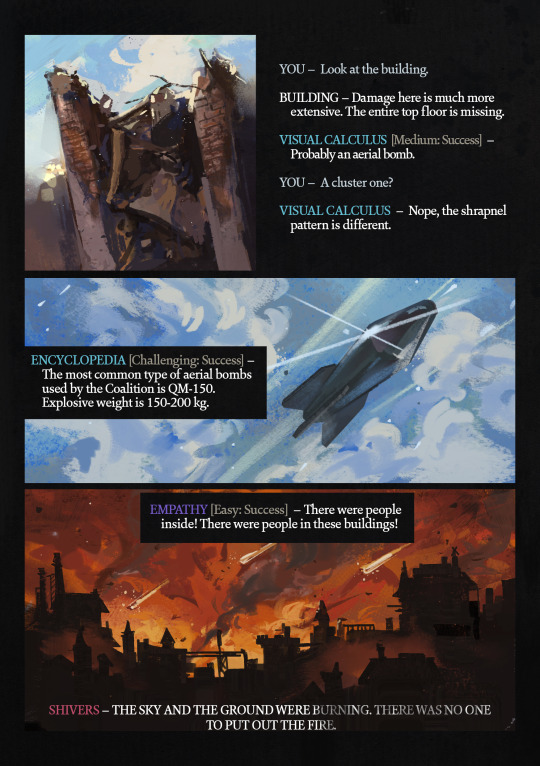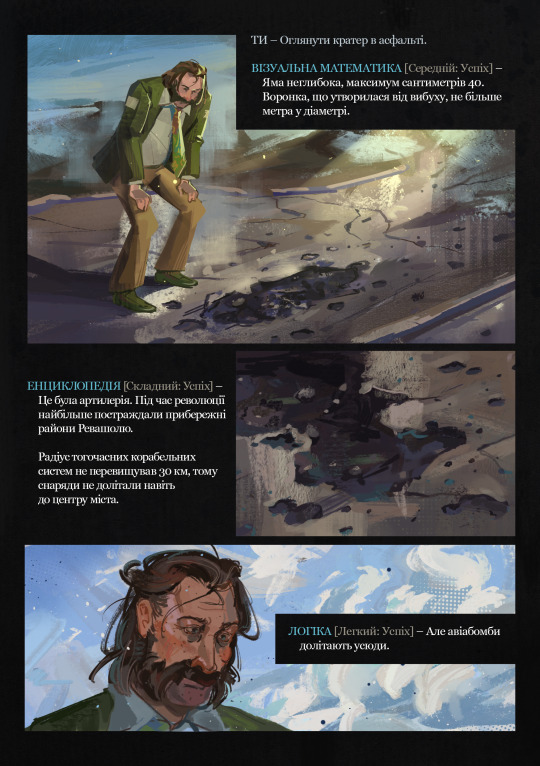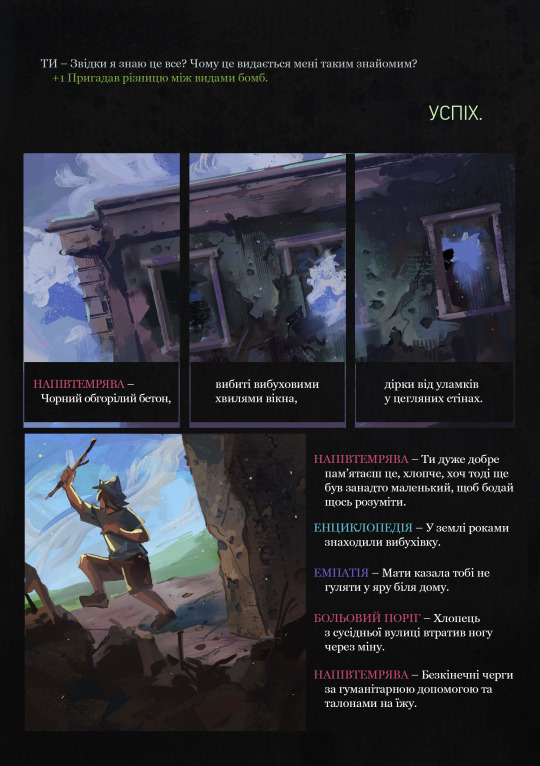look man I just wanted to see some cool mech images.She/Theymechs, ttrpgs, larp shit
Don't wanna be here? Send us removal request.
Text
Actually I’m gonna discourse-post about gothic horror (my favorite horror) for a moment which is probably a bad idea but w/e. Yolo, as the kids no longer say.
Gothic horror is at its root about domesticity as horror. What if your home but haunted. What if your husband but monstrous. What if your family (or in-laws) but twisted and grotesque. What if wealth and comfort but tarnished and controlling. What if love but broken.
It’s a very intimate kind of horror, because houses and families and love are very intimate things. But because it’s about how those intimate things can be made horrifying, it also will of necessity deal with intimate taboos and violations, because those are the things that make intimacy and domesticity horrifying. Of course incest appears in the genre. Of course there’s violence, sexual assault, mental illness. Of course there’s expressions of love, sexuality, and sensuality that are messy in ways that feel dangerous. It’s a genre about safe spaces when they’re not actually safe. It’s about the subjective emotional experience of domesticity gone wrong.
I love the genre in part because it acknowledges this brokenness in ways that are still taboo in broader culture. I love it because often the main characters find a measure of peace after experiencing the emotional tumult of the story. I like that this peace is often highly conditional or strange. Yes, you’ve escaped but you won’t forget it. Yes, you’ve escaped but you’re fundamentally different. Yes, you’re changed, but you escaped. Yes, you’ve changed, but that’s ok. Yes, you’ve changed, and now you’re powerful in a way you finally understand.
It’s fine if you don’t like, well shit, any genre really. But especially a horror genre. My mother couldn’t stand anything scary, and as someone who’d been abused as a child, gothic horror was particularly difficult for her to handle. I get it.
But if you choose to engage with gothic horror, it’s good to remember what it’s about. It’s upsetting on purpose. It’s intimately upsetting on purpose. If you don’t like being upset that way, that’s completely fine and understandable. But it’s not the fault of the genre.
299 notes
·
View notes
Text
Punk Gardening!
It’s that time of year again where you are all out there planting gardens and being anxious about how none of your seeds have come up, or they’re “leggy” or there’s too many weeds or you didn’t water them enough.
And I’m here to say screw all that. You’ve been sold what a “garden should look like” by pesticide and herbicide companies. To be perfectly honest you’ve been sold that about your lawn too, but that’s for another post. It's time to take back gardening and grow some delicious, nutritious food!
So let’s talk about some things that can make you grow a happy, healthy, gnarly-butt garden that’s gonna grow a lot of food and take very little actual effort.
First: Weeds
There’s no such thing. Weeds are a myth. There are plants in your garden that weren’t the ones you planted? Great. Plants like to grow in your dirt. That should make you happy. It means the ones you want to grow will probably also like your dirt and want to grow their fruit/bodies there.
You’ve probably been told non-planted plants take nutrients from the plants you want there. They don’t. Seriously. For one thing, plants need different things, and clover isn’t going to want the same nutrients as your tomatoes, and it’s also probably not going to out-compete your tomatoes for sun. In fact, “weeds” also contribute good things and generally work together with your other plants.
Good plants to see growing in your garden:
Clover: A nitrogen fixer, meaning it will help your garden self-fertilize year to year. You want as much of this as possible in your lawn, too. It’s killed by a lot of major herbicides though, so to justify it’s use, you’ve probably gotten told you want a monoculture of bladelike leaves for the “perfect lawn”. A perfect lawn like that is both really hard to keep alive if not the exact correct type for your yard, and also generally needs added nitrogen fertilizer… because you removed the clover with your herbicide… sigh.
Dandelions: These are great because they have a really deep taproot that breaks up ground and brings water and nutrients to the surface for your other plants to enjoy. This means less watering, less fertilizing, and less need to till the soil before planting! Plus, young dandelion greens, while bitter, make a great topping for a salty sandwich or pasta dish. Their early-season buds can be pickled for capers, and if you’re vegan, cheap, or just want some variety, you can make dandelion “honey” by using dandelion flowers to flavor a sugar syrup.
Henbit: not going to hurt anything, gives good root mats that can help keep water in the soil around your plants, and is also edible, if bitter.
Grass: Similar to henbit, it creates a root mat that aerates soil, keeps in moisture, and prevents erosion.
Plantain: There’s not as much I can say about this one, but it’s not going to hurt anything. And you can make tea out of it if you like.
The only plants I would really take out are the spiky ones (that might make it hard for you to access your food come time for harvest, and are easier to remove when small) and really tall ones with large leaves, which genuinely may shade out smaller plants, especially at the beginning of growing season. If you have a bed near a tree that produces a lot of seedlings, you may also want to be selective about which ones you keep, if any.
Second: Choosing Seeds
You can go the cheap/free way (link), and make yourself a nice dumpster garden out of discarded food scraps. If you’re particularly daring or broke I recommend going to an actual dumpster, since a lot of the discarded produce will be overripe and most plant-able. If you’re gonna invest in seeds, though- make them ones that are native to your area. As my dad found out after several failed years of 2-fruit harvests- growing lemons in Ohio is expensive and futile. Something like sweet potatoes or squash though will be a much better use of your energy.
You can easily recoup your investment in good seeds if you get heirloom and save the seeds for next year, limiting the number of times you’ll have to buy them in a lifetime. A lot of time it’s as easy as letting a few plants/fruits “go to seed” or overripen, then remove and dry the seeds. This is especially easy for brassicas, lettuces, and greens, but can also be done for tomatoes, cucumbers, squashes, and others with a little research and strategic planting to ensure minimal inopportune cross pollination.
Third: Planting and Care of Your Plants
Historically, nature has been pretty dang successful in growing things. Even things humans have decided we like to eat. The biggest thing you can do for yourself here is think “what would nature do?”.
Nature doesn’t till. Generally you can help root veg (carrots, beets, potatoes, etc…) get a little bigger/more uniform by roughing up the soil, but you don’t have to do it for anything else. Not tilling actually helps plants grow longer and more complex root systems, which decreases the need for watering and fertilizing, and they’re more likely to survive high winds.
Nature doesn’t plant things in rows ¼ inch deep. She dumps a ton of seeds in one area, half of them get eaten by birds, the other half sprout and beat each other up trying to get sunlight. A few nice, hardy, delicious plants remain. You can take some advice from this, but also help nature in this regard. I recommend dumping a ton of seeds in a section, then scrabbling your hand through them and the dirt over the area you’d like them to grow. There. Planted. Some will grow too close to each other and may stunt each other’s growth. You can thin to an appropriate distance, and generally eat the sprouts whole in a salad. You’re just gonna have to assume that some of the seeds will be eaten by birds/squirrels and be okay with that. Seeds are cheap and a renewable resource- especially if you got them from a dumpster.
Nature doesn’t start seeds indoors. Just plant when it says on the packet outside.
Nature doesn’t water things regularly. If the soil is super dry when you plant, you may want to dampen it with some tap water. Other than that, water only when it’s been dry for a week or so, or the ground is exceptionally dry despite your clover and grass cover.
Nature doesn’t use petroleum-based fertilizers. She uses composted organic material (vegetable food scraps, yard waste if you’re on a 1-year compost cycle, plus pet waste, meat and dairy scraps if you’re on a 3-5 year cycle), and urine. Yes your urine. It’s great. High in nitrogen. Very free. Add it to your compost or use it directly by mixing it with about 3 parts water. You can either apply it in the rain or just try not to get too much of it on the leaves- pee plus sun will burn leaves.
Finally, nature doesn’t neatly harvest on a particular schedule. Leave a tomato plant out and watch a deer go to town on it. We actually had all of our tomato plants last year eaten down to nubs early in the season, and they came back and gave us one of the best harvests ever! I don’t recommend this as a strategy, per se, but if you’re picking something like greens or basil, harvest by just grabbing handfuls and ripping it off the plant. Our basil and other greens LOVE this and grow massively when we do this.
Fourth: Miscellaneous Tips
Move your plants around year to year. Crop rotation isn’t just a big farm thing. Tomatoes are going to take what they need from the soil but leave the rest and add something back with their own decomposition, which might be something your squash wants next year, etc.. You don’t have to be perfect about it, just try to put things in different places from the year before.
Speaking of which, once you’ve gotten what you can out of them, just chop the plants up and cover them with a little topsoil or mulch at the end of the season. Saves you time and returns everything you can back to the soil. You may get volunteers next season, but really the more the merrier!
Also- some plants you can eat a lot more of than others. For example, the only thing edible on a tomato plant is the tomatoes. But radishes? You can eat the root, the greens, the flowers, and the seed pods, and they are all great! Look into other things you have growing and you might end up with more food than you thought!
Your plants will look weird. That’s okay. Some of the leaves may rot or fall off. The tubers will be weird shapes because they grew next to a rock. Some of them will get eaten or break and be a little behind because they had to grow back. Your tomatoes may have a crack or two in them. Just eat those first. Produce isn’t supposed to be as perfect as it is at the store, and it’s not a problem that it loses a few leaves or is “leggy” at first or other things people worry about. Plants grow, sometimes weirdly. That’s really, genuinely, okay. It very likely won’t harm the end product at all.
2K notes
·
View notes
Text
When inventing a fantasy religion a lot of people a) make the mistake of assuming that everyone in fantasy world would worship the same gods and b) assume that polytheistic religions see all of their gods as morally good
18K notes
·
View notes
Text
Quick-Fire Tips for New Larpers
Splash out on the more expensive fake blood that doesn't stain clothing.
Layering and scarves are your friend when kitting up on a budget.
There will be tons of people at games willing to lend you weapons a props. Just ask!
In general, 'Just Ask!' is a great tule to have.
Prioritise comfort and warmth/lack of warmth when designing kit.
If part of your character isn't fun, just change it. Don't suffer through for the sake of 'the character'.
Don't feel like you immediately have to throw yourself into combat. Taking it slow and doing some training before wading in will make you a better fighter than 50% of the people at a game.
Life is too short for boring meetings. If it sucks, hit the bricks.
Let yourself have the damn wish fulfilment.
Try your hardest not to be intimidated by people who have been larping longer than you. We're all nerds dressed up in a field.
Crewing can be a good way to try out lots of things and figure out what you like without having to pay a lot for it.
Make sure you read the safety document and complaints procedure for every game you go to.
Remember, above all else, this is a hobby we do for fun.
12 notes
·
View notes
Text

Robotgirls in an abandoned factory
(Ink & Watercolor)
6K notes
·
View notes
Text
A Guide To Providing a Decent Crew Experience.
I have almost certainly forgotten something.
Keep reading
81 notes
·
View notes
Text
Slay the Princess Concept Art
We shared a bunch of concept art on Twitter today. Sharing it here, too, where you can find it all in one post. Post contains spoilers, so proceed with caution (or just play the game already if you haven't 😉)
Going to start with the first piece of concept art Abby drew for the game.
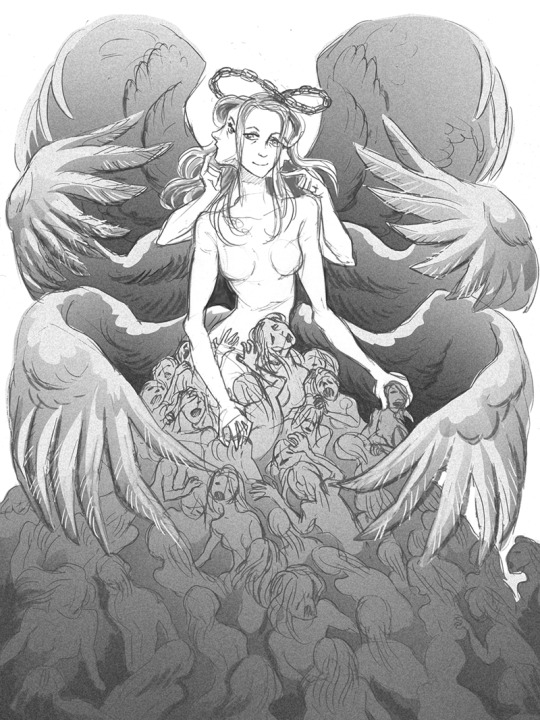
In the earliest stages of development, we toyed around with the concept of there being multiple "end game" forms of the Princess.
The initial outline, rather than being tied together by an overarching metanarrative, structured a full playthrough as a 5-6 chapter long, self-contained journey down a single route, determined by your decisions in chapter 1. Here's an alternative late-game form:

The idea of deviating end-game forms didn't lost for very long, though. As we explored the game's themes more deeply, it made the most sense for there to be a singular "true" form.
If your reality is shaped by subjectivity and perception, then the "truth" has to be what's left when that subjectivity is swept away. the Shifting Mound's final design feels like that initial truth for the Princess, though there's also another truth if you push back against her and press on into the final cabin.
We really liked this "void" design, and I played around with the idea of it being an intermediary to the final form. The "void" Princess would be what you saw upon encountering the final Princess without understanding your own truth, but once you had that understanding, you would see her as the Shifting Mound, as depicted in the game.
That gave way to the intermediary design of the SM being a sea of disembodied limbs, and we also took parts of both designs and incorporated them into the protagonist (particularly the wings.) You can see the eyes and feathers for this void form in the ending card of the original trailer below:

You can see extremely early concept art for the spectre (top), nightmare (top-right), stranger (left), beast (bottom) and ??? (right) as well!
The eyes became a motif in the Nightmare route (Paranoid's manifestation of the fear of being watched), but I also like to think of them as a part of The Long Quiet's truth. You are space and emptiness, but you're also that which observes those things, and it's your perceptions that give the Shifting Mound shape.

Anyways, on the note of the original original concepts for the game, the Princess was initially going to remain human for several loops before taking on more monstrous forms. Some concepts of that are below. Had to get Abby to tone down some of the more horrifically cartoonish designs because they creeped me out and I didn't want to romance them in a video game.
We had to hold our cards close to our chest in the non-metanarrative early drafts, which is part of why, even in the first demo, the cabin doesn't really change much in chapter 2. More room to subtly play with the concept of transformation over time.
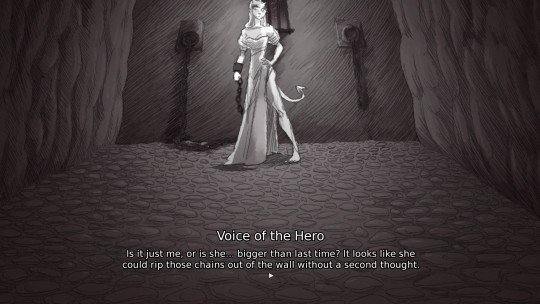
There were a lot of reasons we moved in a different direction for the full release. The branching was unmanageably large to write, and the game felt like a slog to write.
Using an overarching narrative as a framing mechanism in the final version gave us a lot more freedom to explore wildly divergent ideas within routes while still driving the player towards the originally planned finale.
Anyways, now we've got some concept art for individual princesses. There's a lot more than this lying around somewhere, but it's all in sketchbooks, and we'll probably wait until we make an art book to show it off.
First is the tower, who really didn't change much at all. (She got a little thicker, I guess. All of the Princesses did)
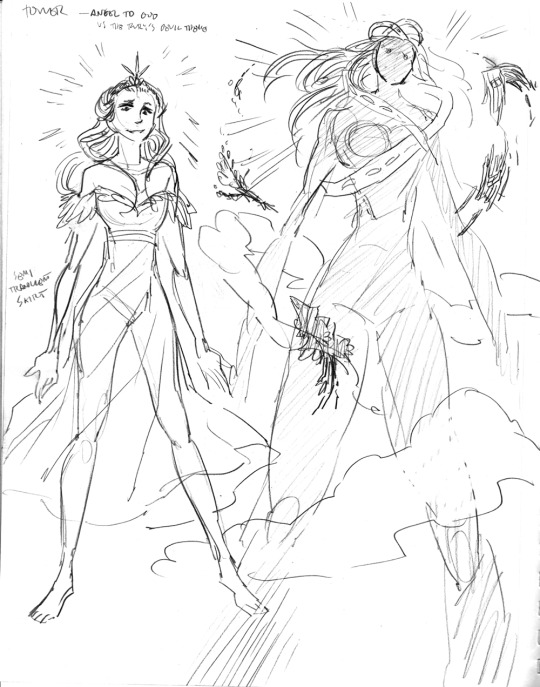

Not a lot to say about her, other than the fact that we knew we wanted a set piece where she gets so big that the trees and cabin orbit around her.
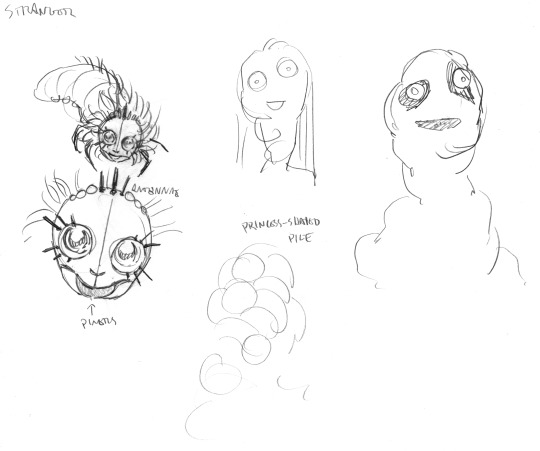
The stranger went through many many redesigns over the course of development. Here, she was a "princess skin" filled with a hive of sentient bugs. The script wasn't working for me, though, so instead she became a peak behind the curtains without the necessary context to know her.
A lot of people ask how these earlier drafts of the Stranger route would have played out, and the answer is I can't tell you, because I couldn't figure out something worth writing.
The writing process for individual routes didn't really start with outlines or plot beats. Rather, the routes started from a theme and a relationship dynamic, and I organically found their outcomes by exploring actions within those themes, and then seeing if those passed Abby's editor brain.
Neither of us found actions we wanted to explore with those versions of the Stranger, at least actions that weren't a beat-by-beat retelling of chapter 1, which contained way too much variation to put on a single chapter 2 route.
If each princess examines a relationship formed by perception and first impressions, the Stranger examines one that's fundamentally unknowable. One where you've seen too much, too quickly.
An insect hive-mind pretending to be a person seemed like a good starting point, but it was too difficult to write any interactions that didn't immediately feel knowable, if still strange. So the final version of the Stranger was designed in such a way where her unknowability makes interacting with her on a human level fundamentally impossible, and you don't get to have a real conversation with her unless you satisfy extremely specific criteria.
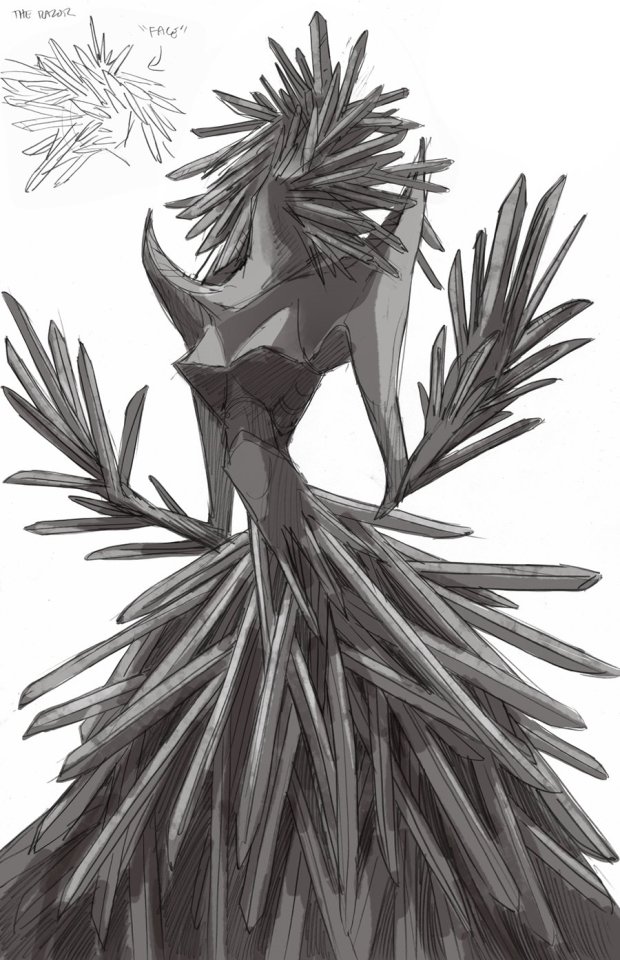
Anyways next up is the razor's final form. We decided she needed more swords.
Hearts became an accidental motif very quickly in the development process, too. (The fact that it is only strikes to the heart that fell her in the demo was accidental, but it felt poetic so we extended it to the rest of the game.)
So on top of adding more swords, we made her heart visible. This is something we did with the fury as well, as a way of showing their emotional (and physical) vulnerability.
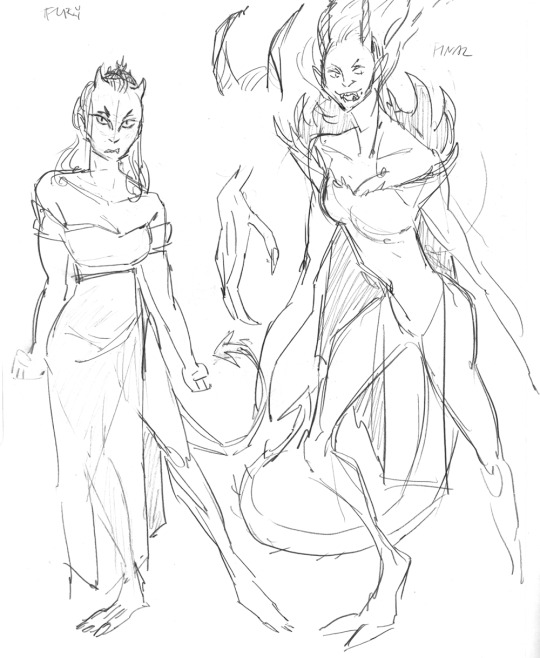
Here's an early version of the Adversary and what would eventually become the Eye of the Needle, back when she was still called the Fury. Originally her hair was going to be fire (as seen on the right), but it didn't feel right in its execution.
She's hit the gym since this concept art. Good for her :)

And we're going to end with the Beast, who at this point was called the Adversary. I think this was before the Witch was added? The Beast was originally designed to be a Questing Beast who lurked in the shadows, where you'd only see glimpses of her, and where each glimpse would make her appear to be a different animal. This was too difficult to execute, though we gave her a more chimera-like appearance in the final game.
This design was from when we still has the Voice of the Obsessed, and the route was going to be a more feral mirror of what eventually became the Adversary, but it felt too thematically similar while being less interesting, so we moved in the direction of making the Beast about consumption as a form of love.
Anyways, that's all we've got for you right now. Hope this was fun!
4K notes
·
View notes
Text
Things Even Experienced Larpers do
Mix up out of character and in character names.
Forget their stats.
Forget the rules.
Forget their own character name.
Mispronounce fictional names.
Forget key character costume and props.
Have to go to bed early due to fatigue.
Trip over themselves when making a big speech.
Get out of character worried when doing an antagonistic action.
Forget to eat.
Oversleep.
Get overstimulated.
Get character bleed.
Literally fall over during combat.
Seriously, it's alright. Don't stress. You have not ruined everything by making a mistake.
141 notes
·
View notes
Text
How high is your bleed threshold?
If you're into roleplaying, you've probably heard about bleed. But do you know what memetic bleed is, or emancipatory bleed? There is a whole network of concepts out there about what spills over between characters and players. And if you've ever wondered why not everyone experiences bleed the same way, you'll love to read about bleed thresholds.
5K notes
·
View notes
Text
7 Larp Resources I Think are Neat
I hoard larp design resources like a magpie. I thought I’d list some I like, with my biases skewing towards uk larp.
1. Larp Design: Creating Role-play experiences.
Immediately, I lie to you. Nordic-focused book about larp design. It's one of many Knutepunkt books (https://nordiclarp.org/wiki/Knutepunkt-books); I find this one the most accessible. Reading it for the first time helped me notice a bunch of things I never even considered to be part of larp design. It has essays on the whole process: from pitching and expectation management, to the different designable surfaces, to debriefing. Also, it got referenced in one of my favourite recent video essays (https://www.youtube.com/watch?v=pgxuGSpOA5k) so that’s nice.
2. Time For An Epic Fight Scene
Really solid look at the different ways UK larps do combat systems and why that is the case. Plus, the back is stacked with interviews with various larp designers. As a cherry on the top, it has a real bibliography so you can follow up with so many extra resources. I love this book so much.
3. Alexandria
Another Nordic focused one, and a mix of larps and rpgs. If you read enough Nordic larp stuff, some common names come up, and this is a great place to look for them. (EG: the 'Just a Little Loving' script is here: https://download.alexandria.dk/files/scenario/4041/JaLL%20Larp%20Script.pdf).
4. Access: Larp
https://accesslarp.wordpress.com/, also at https://accesslarp.tumblr.com/
A lovely set of accessibility resources. It doesn’t look like it’s been updated in a while, though there’s more than enough to read through.. As a disclaimer, I’m recommending it because its a cool resource I found, but note that in no way is it an area I have expertise in so I cannot judge how well it meets its goals.
5. Crooked House's Larp Blogs
https://crookedhouse.org/blogs/
Crooked house have done some expensive larps I have never played. BUT, they are well documented so I can marvel at all their interesting design decisions. God Rest Ye Merry is documented on the site itself, while All for One links to a bunch of frank and in-depth discussions one various ref’s blogs.
6. Roots Part 1 and 2 by J Li
A fascinating lens that helps with drilling down into what ‘types of game’ you can get out of their larp character. It feels like a larp focused cousin to aesthetics of play. I often approach these kinds of taxonomies with scepticism, and yet the fact that I kept saying “oh yeah I recognise this in X player/ Y game” shows this one is a useful lens.
7. Larp Page's LARPbrary
It's the closest thing I’ve found to an attempt to archive old uk larps, and it looks like it's started to update again. It's only got a couple dozen, but it's better than nothing.
More broadly, it makes me wish we took better care to preserve old systems. Even looking for the docs for major systems involves trawling the internet archive, only to find the page/resource you want wasn’t captured. After a larp is finished, so many only exist as third hand accounts, documents on private Facebook groups or dead websites. If you hear of a cool mechanic that exists in an old larp, you may never find it. Worse, ‘old’ here can include larps that ran just a few months prior!
5 notes
·
View notes
Text
i hate how spotify wrapped replaced like all mentions of genres with incoherent tiktok gibberish. anyways you should learn more about music genres, like actually learn about them beyond a basic level. it will seriously improve your enjoyment of music
rateyourmusic's genre tree - super in-depth, each genre has a detailed description, covers niche genres and historical genres
120 genres of edm - good youtube video showing examples of a ton of electronic genres
https://everynoise.com - this is what spotify used for years until the developer got laid off
wikipedia's list of music genres and styles: https://en.wikipedia.org/wiki/List_of_music_genres_and_styles
13K notes
·
View notes
Text
bro i LOVE indigenous fusion music i love it when indigenous people take traditional practices and language and apply them in new cool ways i love the slow decay and decolonisation of the modern music industry
57K notes
·
View notes
Text
There are two types of Mech, the Analog, and the Linked.
Analog mechs are the far, far cheaper of the two. Much less specialized, and infinitely more common, able to be found not just in military use, but in Agricultural and Industrial use as well.
To pilot one, all you need it four limbs (Including prosthetics) and good senses, and to score well in the Simulators to get your license.
Analog is a bit of a misnomer, a holdover word from yesteryear, simply meaning "Less sophisticated."
Analog Mechs work by scanning the Brain Activity of the pilot, comparing it to the physical input of the controls, and deciding what to do from there. They're considered old fashioned and less reliable than Linked Mechs, but they're reliable enough for the work they do. They are more easily replaced and retrofitted for different tasks.
They have simpler AI, and to exit one, you simply take the helmet off and open the hatch.
Linked Mechs are a whole other can of worms.
Each and every Linked Mech is custom built and fitted to their pilot, from the heaviest weapon, to the smallest nut, no one is the same as the other.
Linked Mech are Physically plugged into their pilot's nervous system, and they act as one. It can take hours of Decompression and Disconnection to remove a Linked Pilot.
Linked Mechs are truly nothing without their pilots.
Linked Pilots are the most terrifying people you may ever meet.
Their skin is mottled from the Oxygenator-Coolant that runs in their veins, the plugs and ports too deeply entwined in their flesh and body to be removed without serious disruption to their faculties, hairless and sterile from their conditioning and actions when inside their vessel, and that's only the physical differences.
Depending on how long they've been a Linked Pilot, their mental capabilities are affected in different ways.
'Young' pilots are simply too wary - able to pick up on the most minute details, in all five senses.
Their Mechs are still machine.
'Moderate' pilots have some neurological and mental degradation in addition to what they had before. often confused or forgetful outside of their mech, but still very aware of their surroundings, if not their place in time.
Their Mechs act protective of them, like a dog to it's beloved owner.
'Old' Pilots have all the earlier issues, compounded and worsened, and sometimes confusing themself for their mech, even going so far as to entering refill and Refueling areas of the hangars.
Their Mechs act the same, often trying to reach their pilot's quarters and the Cafeteria.
They may refuse to separate at time, feeling more comfortable together than apart.
and then there are the 'Fused' the oldest and rarest caste of Linked Pilot and Mech.
The Pilot and The Mech fused absolutely, inseparable for Neurological, Psychological, and physical reasons.
They are the same. They are one. A perfect fusion of the Biological and Mechanical, Electrochemical Intelligence and the Fissile-Logic Personality, Mirroring each other with every breath and ventilation protocol.
And they are still people.
The Fused still need social interaction and entertainment. They still need variety and novelty, comfort. All the things anyone else would.
Fused are the least common, but are the least likely to die. Too perfectly combined, Too well accompanied.
The Three times a 'Fused' has been separated, The pilot Died, the Mech 'Bricked' itself, like a Jail-broke phone, no matter how it was done.
Fused are the most loyal, true, and caring of all pilots.
Few ever meet the 'Pilot,' the meat within the metal, but the few that do are those most trusted by the Fused person, as the Fused is showing you their beating heart.
If you earn one's trust, and are given this deep, grand honor, I only have one piece of advice.
Do. Not. Break. That. Trust.
266 notes
·
View notes
Text
character idea: girl mecha pilot who gets dysphoria from being human and spends as much time neural-linked into the mech as possible because that body feels more like her than the flesh does.
mechs are expensive so maybe the only way she can possibly get regular access to one is to put herself in debt to a mercenary corps, running disposable missions until she can pay her junk-tier mech off.
sleeping in her mech to spend as little time out of it until she starts dreaming of static. wearing long sleeves to try and stop herself from picking at the squishy human flesh on her arms. it doesnt work.
maybe neural-links are dangerous for the feedback they provide to the pilot, with few risking to install them. maybe they dont usually provide sensation, but she disables the safety measures because its the only way she can feel alive.
2K notes
·
View notes
Text
Disconnect Syndrome
There’s a reason they put restrictions on how long a Pilot is supposed to be deployed out in the field. They say that being synced with a mech for long periods of time can have detrimental effects on a pilots psyche. Disconnect Syndrome is what they call it, because the symptoms don’t really start to hit until you disengage from your mech.
Sometimes emergencies happen though, and mechs are designed to be able to support their pilots long past the designated “Safe Deployment Time.” The cockpit is equipped with an array of stimulants, vitamins, and nutrient paste to help minimize the physical effects of long deployments. The onboard Integrated Mechanical Personality has largely free reign to administer these as needed to maintain its pilots well-being.
Which is why you’re still able to make it back to the hangar after roughly 36 hours, over four times longer than the established safe period. Your mech had kept you going, helped to keep the exhaustion at bay long enough for you to make your way back from behind enemy lines. You were starting to feel a bit sluggish, but you knew the worst effects of Disconnect Syndrome were yet to come.
An older man in a long white lab coat has joined the usual retinue of crew rushing into the hangar as your mech settles into its cradle. You feel the docking clamps wrap around your limbs, and you know that’s not a good sign. Your IMP whispers comfort into your brain-stem, assurances that things will be okay. It’s probably lying, it’s programmed to help keep your mental state stable, but the thought helps anyway.
There’s a hiss of air as the seal on your cockpit breaks and it decompresses. Suddenly you become aware of your flesh and meat body once again, and it hurts. Pain and exhaustion has settled into your mostly organic bones, and your organs are churning from the strain of the past 36 hours.
Then your interface cables start to disconnect, and it gets worse.
It feels like parts of your mind are being torn out of you. You feel the ghost touch of your IMP in your thoughts as the ports disconnect and you lose direct communication with it. The oxygen mask and nutrition tube pull themselves away from your face and you can’t help but let out a scream of agony. The separation has never felt this painful before, but then again, after 36 hours together, you and your IMP were more intertwined than you’ve ever been before.
Physical sensation finally starts to register again, and you realize tears are streaming down your face just as a technician jabs a needle into your neck.
Immediately your senses start to dull, the pain eases as your thoughts turn sluggish. You slump out of your pilots cradle into the arms the tech who dosed you. Just before your world goes black, you see the doctor standing over you, a grim look on his face.
--
When you wake up again, you immediately know something is wrong. You try to ping your external sensors, but you get no response. You then try to run a diagnostic, but that fails too. In a desperate, last-ditch effort, you try to force access to your external cameras and suddenly light floods your senses. Your instincts catch up first and you blink, trying to clear the pain of the lights, and that’s when you realize it’s not your external cameras that you’re seeing.
It takes a minute or two for your vision to adjust to the light, which feels too long, and when it finally does, the world doesn’t look quite right. You’ve only got access to such a limited spectrum. No infrared, no thermal. The presence of your IMP is notably absent, and your skin feels wrong. You try to sit up, and it’s a struggle to figure out the correct inputs to send to your muscles to get them to do what you want.
The harsh white light of the infirmary grates against your visual processors, you feel like you’re having to re-learn how to control this body. Your body. Technically, at least. Something doesn’t feel right about calling it that anymore. You felt more comfortable crawling back into the hangar after 36 hours deployed than you do now.
The pale skin of your body catches in your vision and you glance down at it. The body's limbs are thinner and more frail than usual, and its skin is paler. Consequences of being in the cockpit for so long, subsisting on nothing but nutrient paste. It’s a far cry from the solid metal plates of your mech, its powerful hydraulic joints, its mounted combat and communication systems.
There’s a button on the side of bed you’ve been deposited in. You think it’s red, but you’re not sure you’re processing color properly right now. You try to reach over and push it, and it takes you a moment to realize you were trying to do so with a limb you don’t currently have.
There are so many things about this body that are wrong. It’s not big enough, or strong enough, or heavy enough. You don’t have enough eyes, sensors, or processors. You have the wrong number of limbs, and they’re all the wrong size and shape.
And there is a distinct void in your mind where the presence of your IMP should be.
The door to your room opens suddenly, and you instinctively try to fire off chaff and take evasive maneuvers. None of that translates properly to your flesh and blood body though, and all that happens is you let out a dry croak from your parched throat.
The man who walks through the door is the same doctor who was present when you disengaged from your mech, and he wears the same grim look on his face as he looks you up and down. You think there’s pity in his gaze, but you can’t quite read him properly right now. The jumbled mess of your brain tells you what he’s going to say before he says it, anyway. The harshest symptoms of Disconnect Syndrome don’t hit until after the pilot has disengaged from their mech.
You’ve already heard the symptoms before, and they map perfectly onto what you’re experiencing. You never thought it would be this painful, or this… discomforting. Your mind reaches for the presence of your IMP, searching for comfort, but you are only reminded that the connection is no longer there.
The doctor gives you a rundown that he’s probably had to do dozens of times, and he tells you that you’ll be grounded for the foreseeable future. That hurts more than anything else. The knowledge that, after all this, you won’t be able to reconnect with your true body, your partner, your other half, for who knows how long.
By the time you realize you’re crying, the doctor is already gone. The longing in your chest and your mind has become unbearable, and through sheer force of will you’re able to push this unwieldy body out of bed. Walking feels wrong, but you’re able to get to your feet and make your way out of the room in an unfamiliar gait.
You have to get back to your partner, you have to make sure it’s okay.
You need to hear her voice in your head again, her reassurances.
The world isn’t right without her presence in your mind.
You stumble into the hangar almost on all fours. How you managed to make it without alerting any personnel feels like a miracle. At least until you catch the eye of a technician lounging in the corner. The look she gives you is full of sympathy, and she jerks her head in the direction of where your mech sits in its docking cradle.
She’s a majestic sight, even through your limited spectrum of vision. 20 meters tall, 6 massive limbs, and bristling with weapons and sensor arrays (all of which have been disarmed by this point).
She’s beautiful.
You clamber frantically up the chassis, easily finding handholds in a frame you know better than the back of your hand. You pull the manual release on the cockpit hatch and stumble into it in a tangle of organic limbs.
Shaking hands grasp the main interface cable from above the pilot’s chair, and you move to slot it into the port in the back of your head. You’ve never done this manually before, usually you’re locked into the chair and the system connects you automatically.
Something about doing it with your flesh and blood hands makes it feel so much more intimate.
The cable clicks into place and your eyes roll back in your head. Tears start to stream down your face as you feel the comforting presence of your IMP rush in and wrap itself around your mind. Your thoughts reach out and embrace it back, sobbing at the relief you feel from being whole once again. You realize you don’t ever want to feel the pain of disconnecting from her again.
There’s a reason they put restrictions on how long a Pilot is supposed to be deployed.
1K notes
·
View notes
